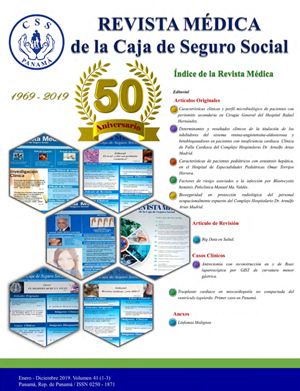ANTRECTOMÍA CON RECONSTRUCCIÓN EN Y DE ROUX LAPAROSCÓPICA POR GIST DE CURVATURA MENOR GÁSTRICA
Contenido principal del artículo
Resumen
Los tumores del estroma gastrointestinal (GIST) son los tumores de origen mesodérmico más comunes del tracto gastrointestinal 70-80%. Se originan de las células intersticiales de Cajal, debido a mutaciones oncogénicas en cKIT/CD117 y PDGFRA (85-90%), los GIST sin mutaciones del controlador en KIT o PDGFRA tradicionalmente se han agrupado como GIST de tipo salvaje KIT/PDGFRA “wild type GIST” y dentro de estos existen subgrupos moleculares. Generalmente son asintomáticos, su ubicación más frecuente: Gástrica (55.6%). La resección laparoscópica constituye el método de elección para la resección del mismo. Se describe que el abordaje quirúrgico está indicado en tumores > 2cm (< 2cm seguimiento endoscópico). El comportamiento biológico del mismo dependerá del tamaño, inmunohistoquímica y número de mitosis en 50 campos de alto poder (histopatológico). Imatinib un fármaco con actividad inhibitoria de receptores tirosina-kinasa aprobado por la FDA en el 2002 para tratamiento de la enfermedad metastásica.
Downloads
Detalles del artículo
Número
Sección

Esta obra está bajo una licencia internacional Creative Commons Atribución-NoComercial 4.0.
Cómo citar
Referencias
1. El-Menyar A. Diagnosis and management of gastrointestinal stromal tumors: An up-to-date literature review. Journal of Cancer Research and Therapeutics 2017; 13:889-900.
2. Ulrich Ronellenfitsch. Surgery for Gastrointestinal Stromal Tumors: State of the Art of Laparoscopic Resection and Surgery for M1 Tumors. Visceral medicine.2018
3. Joshua K. Kays. Approach to wild-type gastrointestinal stromal tumors. Translational Gastroenterology and Hepatol 2018; 3:92.
4. Eric C.H. Lai. Current management of gastrointestinal stromal tumors - a comprehensive review. International Journal of Surgery 10 (2012) 334-340.
5. Kjetil Søreide. Global epidemiology of gastrointestinal stromal tumours (GIST): A systematic review of population-based cohort studies. Cancer Epidemiology 40 (2016) 39–46.
6. National Comprehensive Cancer Network: Clinical Practice Guidelines in Oncology– Soft Tissue Sarcoma. Version 2.2018. www.nccn.org/professionals/physician_ gls/pdf/sarcoma.pdf
7. Marcelo de Paula Loureiro. Laparoscopic resection of gastrointestinal stromal tumors (GIST). ABCD Arq Bras Cir Dig 2016; 29(1):1-4.
8. Juan Correa-Cote. Laparoscopic management of gastric gastrointestinal stromal tumors. World Journal of Gastrointestinal Endoscopy 2014 July 16; 6(7): 296-303.
9. Sebastian Huss MD. Clinicopathological and molecular features of a large cohort of gastrointestinal stromal tumors (GISTs) and review of the literature: BRAF mutations inKIT/PDGFRA wild-type GISTs are rare events. Human Pathology (2017) 62, 206–214.
10. Peter J. Oppelt. Gastrointestinal stromal tumors (GISTs): point mutations matter in management, a review. Journal of Gastrointestinal Oncology Vol 8, No 3 June 2017.
11. Casali et al.Gastrointestinal stromal tumours: ESMO– EURACANClinical Practice Guidelines for diagnosis, treatmentand follow-up. Annals of Oncology 0 (Supplement 0): iv1–iv11, 2018.

